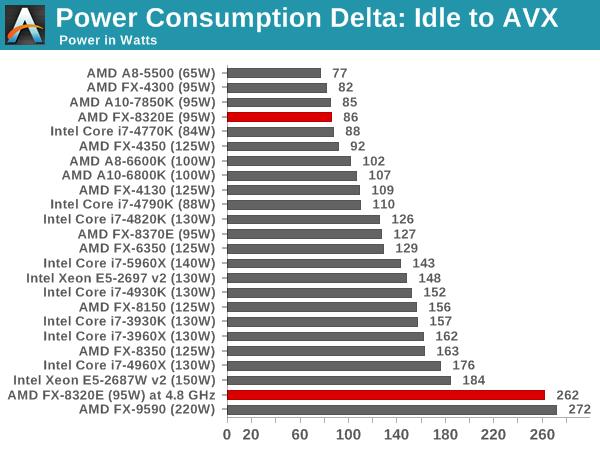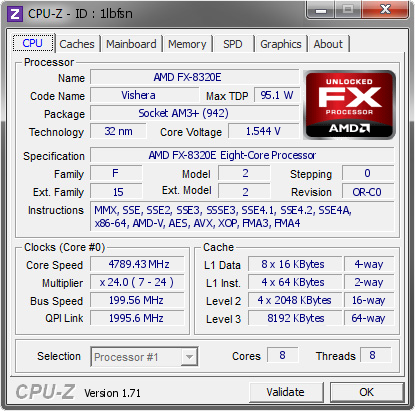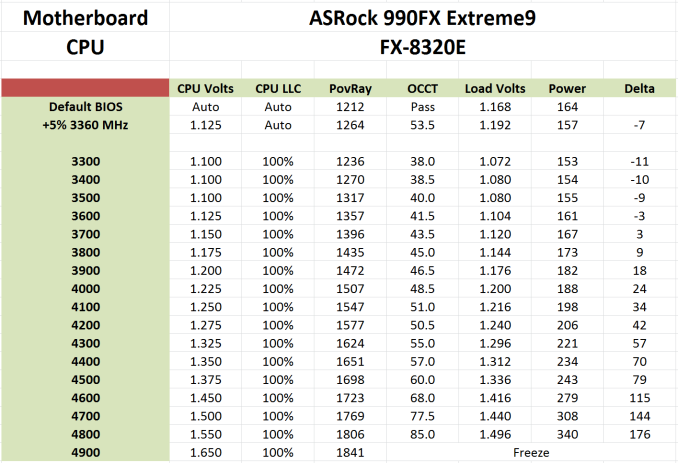AMD FX-8320E CPU Review: The Other 95W Vishera
by Ian Cutress on January 13, 2015 10:00 AM ESTAMD FX-8320E Overclocking
Sometimes looking at CPU overclocking performance is not that relevant. Each CPU ends up being different, and the plural of anecdote is not ‘data’. At some point it might be useful to sample 100+ CPUs of the same type and gain a proper scientific distribution of overclocks, but even then a sample size of 100 is quite small. So our single point in the ether might not matter too much, but the end result this time around was more than interesting.
To put this into perspective, our recent CPU samples here at AnandTech have been bottom of the barrel for our 24/7 validation methods. Our current i7-5960X does 4.4 GHz on a good day, and our fall-back stock testing model only does 4.2 GHz. Similarly we had an i7-4770K that only did 4.1 GHz – that was particularly shocking. Our last true good overclocker was a Sandy Bridge i7-2600K that did 5.3 GHz with a little push but sat at 5.1 GHz comfortably. Since then, horse plop is a nice word to describe it. However, that changed with our FX-8320E sample when paired with our AM3+ CPU test bed, the 990FX Extreme9.
As the voltage was increased, the frequency increased. It kept going, and going, and going. The Nepton 140XL CPU liquid cooler from CoolerMaster kept the temperature low (when I remembered to plug the fan in), but on the other hand the power started to rise. Almost every bump in frequency required an adjustment in voltage, but the increases were small.
At the end of the day, we rose from a 3.2 GHz base frequency all the way up to 4.8 GHz, a +50% overclock.
Methodology
Our standard overclocking methodology is as follows. We select the automatic overclock options and test for stability with PovRay and OCCT to simulate high-end workloads. These stability tests aim to catch any immediate causes for memory or CPU errors.
For manual overclocks, based on the information gathered from previous testing, starts off at a nominal voltage and CPU multiplier, and the multiplier is increased until the stability tests are failed. The CPU voltage is increased gradually until the stability tests are passed, and the process repeated until the motherboard reduces the multiplier automatically (due to safety protocol) or the CPU temperature reaches a stupidly high level (100ºC+). Our test bed is not in a case, which should push overclocks higher with fresher (cooler) air.
Overclock Results
The voltage at 4.8 GHz ran at an alarming 1.550 volts, and the system was stable during our testing when we rested all the benchmarks at this new marker. For 50% extra MHz, our POV-Ray scores jumped from 1212 to 1806, a near 50% jump as well. The only thing that jumped more than 50% was the power consumption. We measured an 86W idle to peak delta when at stock, but the final power was an additional +176W, or +205%, for a total 262W all in, pushing it above the FX-9590's TDP.
Actually in our graphs over the next few pages, the FX-9590 proved to be the best competition when overclocked. That being said, if I were using the CPU 24/7, 1.550 volts at 4.8 GHz would not be the best place to leave it. At 4.5 GHz the CPU only needed 1.375 volts for only a +79W power consumption. Depending on the power delivery of the motherboard, perhaps another couple of notches as well. But all four modules at 4.8 GHz was pretty much unexpected. As always, your mileage may vary.
One argument for our good overclocking sample takes many prongs. A cynic might suggest that this was pre-binned to give a good result, however our past samples from AMD has nothing to suggest that this was particularly special. Karma might suggest that it was just ‘our time’ to get a good sample. A pragmatist would suggest that the FX-8320E is a particularly highly binned part to begin with, and the 30W saving from the regular FX-8320 for only 300 MHz loss might work in its favor depending on how far the voltage curve goes. Again, as stated at the top of this page, it is hard to pin it down without a representative overclocking sample.
Test Setup
| Test Setup | |
| Processor | AMD FX-8320E 4 Modules, 8 Threads, 3.2 GHz, 4.0 GHz Turbo |
| Motherboards | ASRock 990FX Extreme9 |
| Cooling | Cooler Master Nepton 140XL |
| Power Supply | OCZ 1250W Gold ZX Series Corsair AX1200i Platinum PSU |
| Memory | G.Skill RipjawsZ 4x4 GB DDR3-1866 9-11-9 Kit |
| Memory Settings | XMP |
| Video Cards | MSI GTX 770 Lightning 2GB (1150/1202 Boost) |
| Video Drivers | NVIDIA Drivers 337 |
| Hard Drive | OCZ Vertex 3 256GB |
| Optical Drive | LG GH22NS50 |
| Case | Open Test Bed |
| Operating System | Windows 7 64-bit SP1 |
We are using our ASRock 990FX Extreme9 for testing consistency and comparison, despite AMD sampling the MSI 970 Gaming with this review unit. The motherboard and BIOS can affect the performance quite dramatically, and this keeps our numbers comparable to each other.
Many thanks to...
We must thank the following companies for kindly providing hardware for our test bed:
Thank you to OCZ for providing us with PSUs and SSDs.
Thank you to G.Skill for providing us with memory.
Thank you to Corsair for providing us with an AX1200i PSU.
Thank you to MSI for providing us with the NVIDIA GTX 770 Lightning GPUs.
Thank you to Rosewill for providing us with PSUs and RK-9100 keyboards.
Thank you to ASRock for providing us with some IO testing kit.
Thank you to Cooler Master for providing us with Nepton 140XL CLCs.
Load Delta Power Consumption
Power consumption was tested on the system while in a single MSI GTX 770 Lightning GPU configuration with a wall meter connected to the OCZ 1250W power supply. This power supply is Gold rated, and as I am in the UK on a 230-240 V supply, leads to ~75% efficiency > 50W, and 90%+ efficiency at 250W, suitable for both idle and multi-GPU loading. This method of power reading allows us to compare the power management of the UEFI and the board to supply components with power under load, and includes typical PSU losses due to efficiency.
We take the power delta difference between idle and load as our tested value, giving an indication of the power increase from the CPU when placed under stress.

86W undercuts the 95W TDP by a good margin, however one might suggest that the power efficiency difference of the power supply would take that into account. The stock load voltage was 1.168 volts in our motherboard, which does not suggest anything untoward regarding the VID.












92 Comments
View All Comments
mostlyharmless - Tuesday, January 13, 2015 - link
"These processors are similar to their non-E counterparts, the FX-8370 and FX-8320, but with a lower base frequency but the same turbo frequency. This means, in theory, they should be as quick and responsive for most day-to-day tasks as their 125W brethren, but a bit behind when it comes to the hardcore processor mechanics. "Given what's said in the first sentence, isn't the second sentence just the opposite of the logical conclusion?
evilspoons - Tuesday, January 13, 2015 - link
No. It bursts to the same frequency when it is otherwise idle, because power over time (heat output) has been low, so 'day to day tasks' are the same. But when you push it hard and you hit the thermal overhead, the fact it's capped at 100 instead of 125 means it's going to throttle back faster and therefore be slower.mostlyharmless - Tuesday, January 13, 2015 - link
Thanks! A much clearer explanation.OrphanageExplosion - Tuesday, January 13, 2015 - link
You guys really need to find a series of gaming benchmarks that are actually CPU heavy - none of those titles are (BF4 yes - but not that area). How about AC Unity or Crysis 3 for starters. Total War? Some more games that people are actually playing, perhaps?postem - Tuesday, January 13, 2015 - link
This is actually much more easy for them, as they already have a load of tests of the games on the review. They just tested the same games with this cpu and put the graph.BTW if you put this cpu and expect any stellar performance in gaming, and any AMD cpu, even the 220W monster you will be suffering.
I was using a i7 950 @ 4.2. Until i updated to a 4790K i didnt realize how much bottleneck i had. Not only that but stutterfest was gone.
Meanwhile, paying for a budget machine for office i would go with i3 or new pentium. The price difference isnt that much and you get more performance per buck.
Getting the 220W processor is a complete insane bid; unless you are a fanatic AMD supporter, you can clearly get a better deal in terms of cooling and performance with an i5.
StevoLincolnite - Tuesday, January 13, 2015 - link
My Upgrade from the Phenom 2 x6 1090T to my Core i7 3930K says otherwise.Same with the jump between my 3930K and 5930K.
Granted... I also run in eyefinity, I am always GPU limited.
yannigr2 - Wednesday, January 14, 2015 - link
Unless you are a fanatic Intel supporter, for an office machine you will go with a quad core FM2/+ processor.OrphanageExplosion - Wednesday, January 14, 2015 - link
Unless you want some kind of viable CPU upgrade path.jabber - Wednesday, January 14, 2015 - link
Office machines getting upgrades? HahahahahaaaaaaaaMeanwhile back in the real world!
phoenix_rizzen - Thursday, January 15, 2015 - link
We've successfully upgraded our AMD-based systems from Sempron to Athlon-II X2 to Athlon-II X3 to Athlon-II X4 without changing motherboards.Over the years we've switched motherboards in our systems for newly purchased systems, but even those have had CPUs upgraded.
In our server systems, we've gone from AMD Opteron 6100 to 6200 to 6300 (8-core to 16-core) without changing motherboards.
It's one of the main reasons we've standardised on AMD for just about everything: you can upgrade CPUs without changing motherboards. (Up to a point, of course; when we need more features from the chipset or faster versions of RAM, then we'll change motherboards.)
The other nice thing about AMD CPUs is that every CPU supports all the same features (mainly the virtualisation-related features) across all models (even Sempron CPUs support SVM). Trying to decipher the Intel CPU feature matrix and model numbers is a nightmare! And they change CPU sockets on an almost yearly basis.